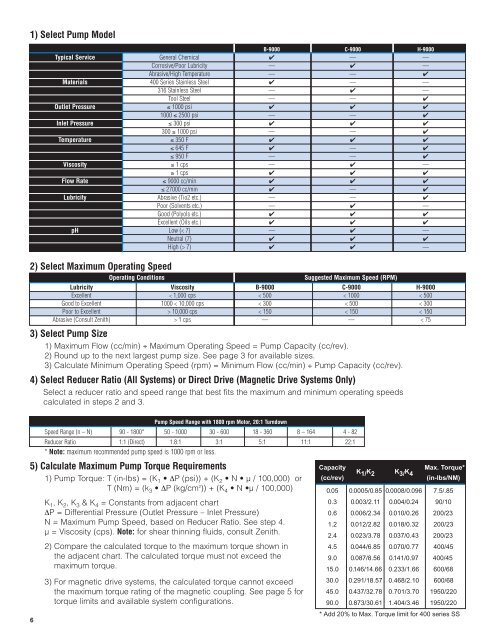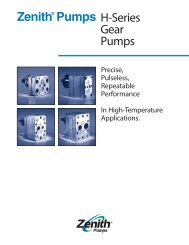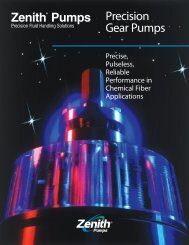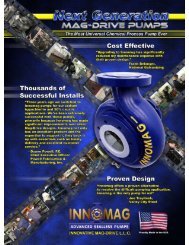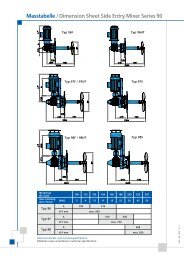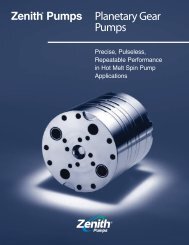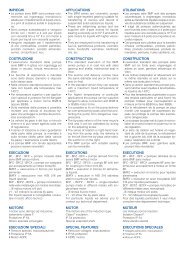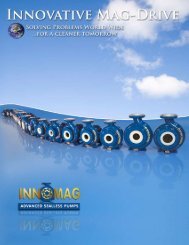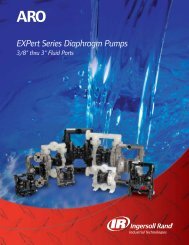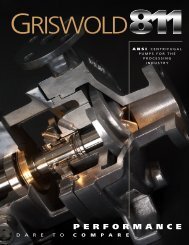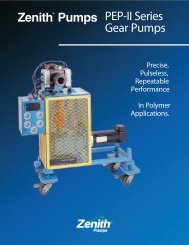Zenith® Pumps 9000 Series Gear Pumps - LUBOSA
Zenith® Pumps 9000 Series Gear Pumps - LUBOSA
Zenith® Pumps 9000 Series Gear Pumps - LUBOSA
- No tags were found...
Create successful ePaper yourself
Turn your PDF publications into a flip-book with our unique Google optimized e-Paper software.
1) Select Pump ModelB-<strong>9000</strong> C-<strong>9000</strong> H-<strong>9000</strong>Typical Service General Chemical ✔ — —Corrosive/Poor Lubricity — ✔ —Abrasive/High Temperature — — ✔Materials 400 <strong>Series</strong> Stainless Steel ✔ — —316 Stainless Steel — ✔ —Tool Steel — — ✔Outlet Pressure ≤ 1000 psi ✔ ✔ ✔1000 ≤ 2500 psi — — ✔Inlet Pressure ≤ 300 psi ✔ ✔ ✔300 ≤ 1000 psi — — ✔Temperature ≤ 350 F ✔ ✔ ✔≤ 645 F ✔ — ✔≤ 950 F — — ✔Viscosity ≤ 1 cps — ✔ —≥ 1 cps ✔ ✔ ✔Flow Rate ≤ <strong>9000</strong> cc/min ✔ ✔ ✔≤ 27000 cc/min ✔ — ✔Lubricity Abrasive (Tio2 etc.) — — ✔Poor (Solvents etc.) — ✔ —Good (Polyols etc.) ✔ ✔ ✔Excellent (Oils etc.) ✔ ✔ ✔pH Low (< 7) — ✔ —Neutral (7) ✔ ✔ ✔High (> 7) ✔ ✔ —2) Select Maximum Operating SpeedOperating ConditionsSuggested Maximum Speed (RPM)Lubricity Viscosity B-<strong>9000</strong> C-<strong>9000</strong> H-<strong>9000</strong>Excellent < 1,000 cps < 500 < 1000 < 500Good to Excellent 1000 < 10,000 cps < 300 < 500 < 300Poor to Excellent > 10,000 cps < 150 < 150 < 150Abrasive (Consult Zenith) > 1 cps — — < 753) Select Pump Size1) Maximum Flow (cc/min) ÷ Maximum Operating Speed = Pump Capacity (cc/rev).2) Round up to the next largest pump size. See page 3 for available sizes.3) Calculate Minimum Operating Speed (rpm) = Minimum Flow (cc/min) ÷ Pump Capacity (cc/rev).4) Select Reducer Ratio (All Systems) or Direct Drive (Magnetic Drive Systems Only)Select a reducer ratio and speed range that best fits the maximum and minimum operating speedscalculated in steps 2 and 3.6Pump Speed Range with 1800 rpm Motor, 20:1 TurndownSpeed Range (n – N) 90 - 1800* 50 - 1000 30 - 600 18 - 360 8 – 164 4 - 82Reducer Ratio 1:1 (Direct) 1.8:1 3:1 5:1 11:1 22:1* Note: maximum recommended pump speed is 1000 rpm or less.5) Calculate Maximum Pump Torque Requirements1) Pump Torque: T (in-lbs) = (K 1 • ∆P (psi)) + (K 2 • N • µ / 100,000) orT (Nm) = (k 3 • ∆P (kg/cm 2 )) + (K 4 • N •µ / 100,000)K 1 , K 2 , K 3 & K 4 = Constants from adjacent chart∆P = Differential Pressure (Outlet Pressure – Inlet Pressure)N = Maximum Pump Speed, based on Reducer Ratio. See step 4.µ = Viscosity (cps). Note: for shear thinning fluids, consult Zenith.2) Compare the calculated torque to the maximum torque shown inthe adjacent chart. The calculated torque must not exceed themaximum torque.3) For magnetic drive systems, the calculated torque cannot exceedthe maximum torque rating of the magnetic coupling. See page 5 fortorque limits and available system configurations.Capacity(cc/rev)Max. Torque*K 1/ K 2 K 3/ K 4(in-lbs/NM)0.05 0.0005/0.85 0.0008/0.096 7.5/.850.3 0.003/2.11 0.004/0.24 90/100.6 0.006/2.34 0.010/0.26 200/231.2 0.012/2.82 0.018/0.32 200/232.4 0.023/3.78 0.037/0.43 200/234.5 0.044/6.85 0.070/0.77 400/459.0 0.087/8.56 0.141/0.97 400/4515.0 0.146/14.66 0.233/1.66 600/6830.0 0.291/18.57 0.468/2.10 600/6845.0 0.437/32.78 0.701/3.70 1950/22090.0 0.873/30.61 1.404/3.46 1950/220* Add 20% to Max. Torque limit for 400 series SS


